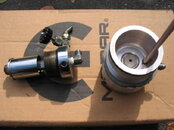oxyhacker
Guest
- Messages
- 1,314
- Reaction score
- 44
This is one of the many mysteries of the HP-air world - how a cheesy little element that looks like it would cost about $8 if it was for an LP compressor can cost $50 for HP. Not Ray's fault, though - the Bauer ones to go for about the same or more, though one can find the Mako ones for $30 sometimes.
If you are tempted to roll your own from cheap LP components, LF uses 20 micron elements in their HP coalescors, so that makes a good starting point. Most shops and catalogs that have LP air stuff will also have replacement elements, though it is often easier to cannabalize a cheap LP filter to get one. Though I have found that the newer ones tend to have plastic elements, which may not be as suitable.
Seeing as how the low end Italian compressors may use nothing but a tube with some holes in the side, and the Rix uses just a rolled up piece of screen, I suspect any sintered element of approximately the right micron rating will do a reasonable job.
If you are tempted to roll your own from cheap LP components, LF uses 20 micron elements in their HP coalescors, so that makes a good starting point. Most shops and catalogs that have LP air stuff will also have replacement elements, though it is often easier to cannabalize a cheap LP filter to get one. Though I have found that the newer ones tend to have plastic elements, which may not be as suitable.
Seeing as how the low end Italian compressors may use nothing but a tube with some holes in the side, and the Rix uses just a rolled up piece of screen, I suspect any sintered element of approximately the right micron rating will do a reasonable job.
but, based on the increases on the stuff he is making up for me now, I will guess $50 ish.




